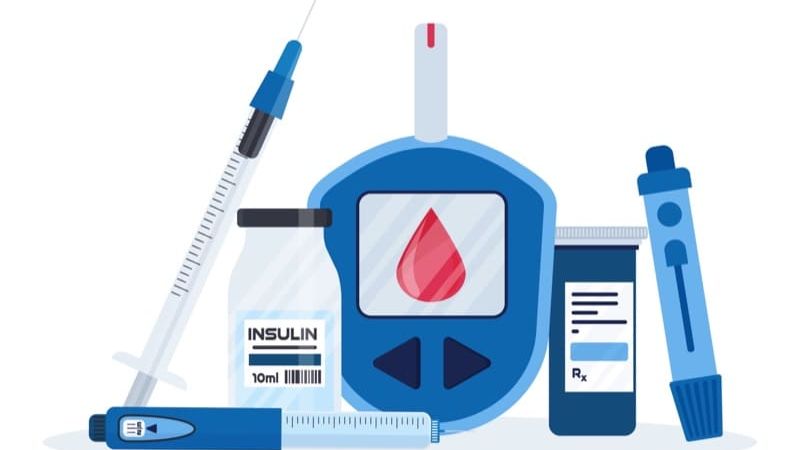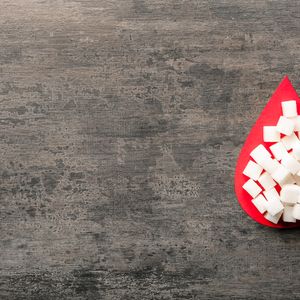

Our Review Process
Our articles undergo extensive medical review by board-certified practitioners to confirm that all factual inferences with respect to medical conditions, symptoms, treatments, and protocols are legitimate, canonical, and adhere to current guidelines and the latest discoveries. Read more.
Our Editorial Team
Shifa Fatima, MSc.
Author
Dr. Apoorva T, MHM.
MEDICAL ADVISOR
Insulin: Everything You Need to Know
Insulin is a hormone released by the pancreas to regulate bodily functions. When you consume a food item that contains starch or carbohydrates, it gets broken down to its simplest form to be used by the body for energy. The simplest unit is sugar or glucose. Insulin allows the sugar to be absorbed by the body and signals it to use sugar for energy. When the body is unable to release sufficient insulin or when the organs don’t react to insulin in the proper manner, the blood sugar levels rise or drop which can be dangerous for the body and cause organ or nerve damage. This means insulin is responsible for the proper utilization of glucose. If there is too much in your blood, then insulin ensures it is stored in the liver till your body needs it again.
Let us see the effect of irregular insulin on the body.
| - | Low range of insulin | High range of insulin | normal range of insulin |
|---|---|---|---|
| Blood | It causes high glucose levels | It causes blood sugar to reduce | Glucose levels are maintained within limits irrespective of food intake. |
| Symptoms | Since excess glucose is expelled from the body through urination, frequent visits to the washroom and feeling thirsty are commonly seen. | Frequent and intensive hunger, excessive cravings for sugar, weight gain, and fatigue are some of the symptoms. | When the body has normal levels of insulin, your blood sugar will be steady and you will feel fine irrespective of the type of food you consume. |
| Long term effects | This can lead to hypoglycemia unawareness. This means the brain no longer detects irregularities in blood sugar. This increases the risk of life-threatening situations due to high blood sugar. | This can lead to an increased risk of obesity, type 2 diabetes, and cardiovascular diseases, and reduces life expectancy span. | This increases life expectancy and ensures bodily functions are normal and organs are healthy. |
| Tips to manage | Choose to eat lesser portion sizes and consume less sugar and starch. Follow an exercise regime religiously. | Try to establish a routine for sleep, exercise, and a diet plan. Cut down on carbs and reduce your intake of sugar. Weight loss can help too. | Ensure you include exercise in your routine and consume foods in moderation. |
Table of Contents
What is Insulin?
Insulin is a hormone synthesized and released by the beta-cells of the pancreas. Broadly, Insulin regulates carbohydrate, fat, and protein metabolism and also maintains blood sugar levels. It is secreted in response to the increase in glucose levels in the bloodstream.
The simplest unit is sugar or glucose. Insulin allows the sugar to be absorbed by the body and signals it to use sugar for energy. When the body is unable to release sufficient insulin or when the organs don’t react to insulin in the proper manner, the blood sugar levels rise or drop which can be dangerous for the body and cause organ or nerve damage. Know more about high blood sugar symptoms.
What Does Insulin Do?
After you eat a meal, the digestive juices in your stomach break the food carbohydrates into glucose. Glucose is absorbed into your bloodstream through the micro-lining of the small intestine, which leads to an increase in blood glucose levels. Insulin helps the cells uptake glucose from the bloodstream for normal cellular functioning.
Insulin maintains the equilibrium of blood glucose at any given point, and excess glucose in the blood is stored as glycogen in the liver. Further, excess glucose is stored in fat tissues and muscles. Similarly, when you fast, your blood glucose levels decrease. This leads to the pancreas switching off the secretion of insulin into the bloodstream. Then, stored glucose is released into your bloodstream to restore equilibrium and normal body functioning. Hence, insulin regulates the metabolism of carbohydrates, fats, and proteins. Know more about medications for diabetes. Know about medications for diabetes.
This means insulin is responsible for the proper utilization of glucose. If there is too much in your blood, then insulin ensures it is stored in the liver till your body needs it again. Know about medications for diabetes.
Effects of Different Doses of Insulin on body
Effects on Blood Glucose
1. Low Range of Insulin
It causes high glucose levels
2. High Range of Insulin
It causes blood sugar to reduce
3. Normal Range of Insulin
Glucose levels are maintained within limits irrespective of food intake.
Also read about urine sugar level
Symptomatic Effects
1. Low Range of Insulin
Since excess glucose is expelled from the body through urination, frequent visits to the washroom and feeling thirsty are commonly seen.
2. High Range of Insulin
Frequent and intensive hunger, excessive cravings for sugar, weight gain, and fatigue are some of the symptoms.
3. Normal Range of Insulin
When the body has normal levels of insulin, your blood sugar will be steady and you will feel fine irrespective of the type of food you consume.
Long Term Effects
1. Low Range of Insulin
This can lead to hypoglycemia unawareness. This means the brain no longer detects irregularities in blood sugar. This increases the risk of life-threatening situations due to high blood sugar.
2. High Range of Insulin
This can lead to an increased risk of obesity, type 2 diabetes, and cardiovascular diseases, and reduces life expectancy span.
3. Normal Range of Insulin
This increases life expectancy and ensures bodily functions are normal and organs are healthy.
Management Tips
1. Low Range of Insulin
Choose to eat lesser portion sizes and consume less sugar and starch. Follow an exercise regime religiously.
2. High Range of Insulin
Try to establish a routine for sleep, exercise, and a diet plan. Cut down on carbs and reduce your intake of sugar. Weight loss can help too.
3. Normal Range of Insulin
Ensure you include exercise in your routine and consume foods in moderation.

Diabetes Overview
Diabetes occurs when there is any irregularity in blood sugar level due to ineffective insulin. It means either the body is producing too much or too little, or the body is not able to absorb the right amount of insulin required to regulate functions. Either way, the blood glucose levels get affected and it can be harmful to a person’s health. There are 2 main types of diabetes, type 1 and type 2. Let us learn more about each of these.
Type 1 diabetes – Type 1 diabetes is an autoimmune disease, which causes the defense mechanism of the body to destroy the good cells in the body because it mistakes them for the harmful ones. In this case, the body cannot produce enough insulin due to damage to the good cells. Type 1 diabetes is usually detected in young people.
Type 2 diabetes – This type of diabetes is seen in people of any age. When the body becomes resistant to insulin, the body starts to produce more of it but after a while, the cells burn out. The insensitivity to insulin can be an issue and cause a spike in blood sugar levels. The most common cause of type 2 diabetes is weight gain.
How are Insulin and Diabetes related?
Diabetes is a metabolic disorder, usually a consequence of your pancreas not producing enough insulin or your body not responding properly to insulin. The functioning of insulin varies in individuals with Type 1 and Type 2 diabetes.
- Type 1 Diabetes is an autoimmune disorder, and the immune system destroys the beta-cells of the pancreas. Consequently, your body is unable to produce insulin. That’s why this type is also known as Insulin-dependent Diabetes Mellitus (IDDM). This type is more common in the younger population.
- Type 2 Diabetes is characterized by the increased resistance and reduced sensitivity of the body to insulin. This condition requires more insulin to produce the same effect, and it burdens the pancreas cells to produce more insulin, consequently leading to their burnout and they become non-functional. This type of diabetes is also known as Non-insulin-dependent Diabetes Mellitus (NIDDM) and usually develops in the later stages of life.
What are the Possible Side Effects of Human Insulin?
Sure there are insulin benefits, but one cannot ignore the side effects that come with human insulin. If your health condition requires you to take human insulin, you may experience the following side effects:
- Hypoglycemia (low blood sugar)
- Weight gain
- Lumps, itching, redness, or swelling at the injection site
If insulin sugar is taken in the prescribed amount and with utmost precaution, you may not experience any side effects. Even if you do, most side effects will be temporary. Know more about signs and symptoms of diabetes mellitus.
Diabetes Treatment with Insulin
Now, you have seen that insulin is required in both types of diabetes. When your body is not producing it or is not properly responding to it due to reduced sensitivity, insulin has to be injected from outside as a replacement or supplement to meet the requirement and maintain blood glucose levels.
- Individuals with Type 1 Diabetes must inject insulin to control blood glucose levels as their bodies are unable to produce it.
- Individuals with Type 2 Diabetes usually manage their blood glucose levels with oral antidiabetic medications and lifestyle or behavioral changes. However, when these measures are ineffective in controlling blood glucose levels, they may also require insulin to maintain blood glucose levels. Know more about signs and symptoms of diabetes mellitus.
Types of Insulin
The American Diabetes Association (ADA), classifies insulin diabetes based on how fast it acts.
- Rapid-acting Insulin : Usually begins to act 15 minutes following the injection, reaching peak effect in an hour. The effect stays for a few more hours and then fades away.
- Short-acting Insulin : Begins to affect blood sugar approximately 30 minutes after the injection and peaks, ranging between 2 and 3 hours. The effect usually stays for 3-6 hours.
- Intermediate-acting Insulin : Usually takes 2-4 hours to exert full effect and can be effective for 18 hours.
- Long-acting Insulin : Reaches the bloodstream 1-2 hours following the injection and can have a full-day effect. There are no designated peaks with long-acting insulin, and it works like natural insulin.
Here is the different types of insulin chart:
| Insulin Name | When does it start working? (onset) | When will the effect be the greatest? (peak) | How long will it lower blood glucose? (duration) | Notes for Use |
|---|---|---|---|---|
| Rapid Acting | - | - | - | - |
| Lispro (Humalog") | <15 minutes | 0.5-3 hours * | 3-5 hours | If mixing with NPH, rapid acting insulin should be drawn into syringe first. Mixture should be given immediately to avoid effects on peak action. |
| Aspart (NovologTM) | <15 minutes | 0.5-3 hours * | 3-5 hours | If mixing with NPH, rapid acting insulin should be drawn into syringe first. Mixture should be given immediately to avoid effects on peak action. |
| Glulisine (ApidraTM) | <15 minutes | 0.5-3 hours * | 3-5 hours | If mixing with NPH, rapid acting insulin should be drawn into syringe first. Mixture should be given immediately to avoid effects on peak action. |
| Short Acting | - | - | - | - |
| Regular (Novolin RTM or Humulin RTM) | 0.5-1 hour | 2-4 hours | 4-8hour | May be mixed with NPH in same syringe. Mixing order should be the clear regular drawn up first, then the cloudy NPH (ie clear to cloudy). |
| Intermediate Acting | - | - | - | - |
| NPH (Novolin NTM or Humulin NTM) | 2-4 hours | 4-10hours | 10-18hours | Available as pen or in vial to be used with syringe. |
| Long Acting | - | - | - | - |
| Glargine (LantusTM) | 4-6 hours | action throughout the day | 24hour | Do not mix with other insulins. Available as pen or in vial. Duration (clinical trial data): 6 hrs (0.1 U/kg), 12 hrs (0.2 U/kg),20 hrs (0.4 U/kg), 23 hrs (0.8 U/kg and | 1.6 U/kg) |
| Detemir (Levemir") | 2-3hour | 6-8 hours | Dose-dependent 5.7-23.2 hours | - |
| Combinations | - | - | - | - |
| Humulin or Novolin 70/30 | 0.5-1 hour | 2-10 hours | 10-18 hours | 70% NPH +30% regular insulin. Insulin action includes 2 peaks (1 from each formulation). |
| Novolog Mix 70/30 Humalog Mix 75/25 or 50/50 | <15 minutes | 1-2 hours | 10-18 hours | Novolog Mix: aspart protamine 70% + aspart 30% Humalog mix: 75/25=75% lispro protamine + 25% lispro 50/50=50% lispro protamine + 50% lispro Insulin action includes 2 peaks (1 from each formulation). |
Insulin Dosage and How to Inject Insulin?
Insulin is usually self-administered using a specific syringe with markings on it. Insulin syringes come in different sizes depending on the dose of insulin you need. It is very important to discuss the prescribed quantity with your doctor and use the correct size of insulin syringe to make sure you get the right dose at designated intervals to maintain blood glucose levels.
Insulin can be injected in a couple of areas of your body like abdomen, upper arm, buttocks, hip, and the front or side of the thigh. However, insulin works fastest when it is injected into the abdomen. Nowadays, apart from the conventional syringes, various other innovative and easy-to-use products are available in the market, including Insulin Pens, Insulin Pumps, and Jet pumps. In 2014, inhalational insulin was approved for use in diabetes to relieve injection pain and other injection site reactions. Read about how to reduce diabetes.
What if I stop taking Insulin?
In the absence of adequate insulin levels in the body, you can develop another metabolic disorder, called Diabetic Ketoacidosis (DKA). It is characterized by the body breaking down fats to produce energy and releasing ketones as a byproduct. These ketone bodies accumulate in the bloodstream and can lead to brain swelling, and the body can go into shock.
Other complications of DKA could be Hyperglycemia characterized by increased blood glucose levels and Insulin Shock caused by low blood glucose levels while using too much insulin. So, regular monitoring of blood glucose levels, insulin intake, and doctor's monitoring are critical when it comes to regulating Insulin imbalance.
Insulin Benefits & Limitations in Type 1 & 2 Diabetes
In Type 2 Diabetes, your body’s ability to produce sufficient insulin decreases and you may be asked to take insulin injections to manage it. But Insulin therapy comes with its own set of Pro's and Con's.
Pro's
- Insulin is a strong medication and is effective in reducing the symptoms of high blood sugar like fatigue and frequent need to urinate
- Reduces the risk of developing diabetic complications
- Decreases and relieves the strain on the pancreas to produce insulin and helps in beta cell recovery
Con's
- Raises the Risk of Hypoglycemia
- Can lead to Weight Gain
- Discomfort with Injections
Bottom Line
It is now clear that Insulin is important for normal body functioning to regulate almost everything you eat. If your body is unable to produce it, it can lead to the development of diabetes, which could further damage the pancreas. Consequently, this leads to insulin administration as a replacement or supplement. You should adopt a healthy diet, exercise regularly, and get physically active. These healthy habits will help you reduce the risk of insulin resistance and the chances of developing Type 2 diabetes. You are stronger than you think! So get up and leave the shackles of a poor lifestyle. Take baby steps to adopt healthy habits, and once the results become visible, you will be inspired to do more.
FAQs
1. How to take insulin without a syringe?
If you do not prefer syringes, you can opt for an insulin pen. Once you have used the pen, you can throw it out.
2. How should I store my insulin?
Insulin should be kept in the fridge between 2.2 to 7.7 degrees Celsius. It should not be frozen and it should not be exposed to direct sunlight either. It cannot be exposed to direct heat or cold.
3. What is Insulin resistance?
Insulin resistance is the inability of the body to use insulin for the absorption of glucose from the blood to its cells to be used to generate energy.
4. Can you survive diabetes without insulin?
In the case of type 1 diabetes, if insulin is not made available to the person, it could result in organ failure and eventual death. In the case of type 2 diabetes, some people require insulin injections to reduce sugar levels and keep them steady enough for living a healthy life.
5. Does Heat Destroy Insulin?
Leaving insulin exposed to an extreme temperature for even 60 minutes can render it useless. For example, if you leave insulin exposed to a very cold or very hot temperature for too long, it can break down to the point where it no longer has any real impact on your blood sugar levels.
References
- https://www.healthline.com/health/type-2-diabetes/insulin
- https://my.clevelandclinic.org/health/articles/22601-insulin
Disclaimer
This website's content is provided only for educational reasons and is not meant to be a replacement for professional medical advice. Due to individual differences, the reader should contact their physician to decide whether the material is applicable to their case.
More by Shifa Fathima

अर्जुनरिष्ट: फायदे, खुराक, नुकसान | पढ़ें | Sugar.fit

मधुमेह के लिए मधुनाशिनी वटी: उपयोग, लाभ, खुराक और दुष्प्रभाव|

मधुमेह को नियंत्रित करें भारतीय आहार से





